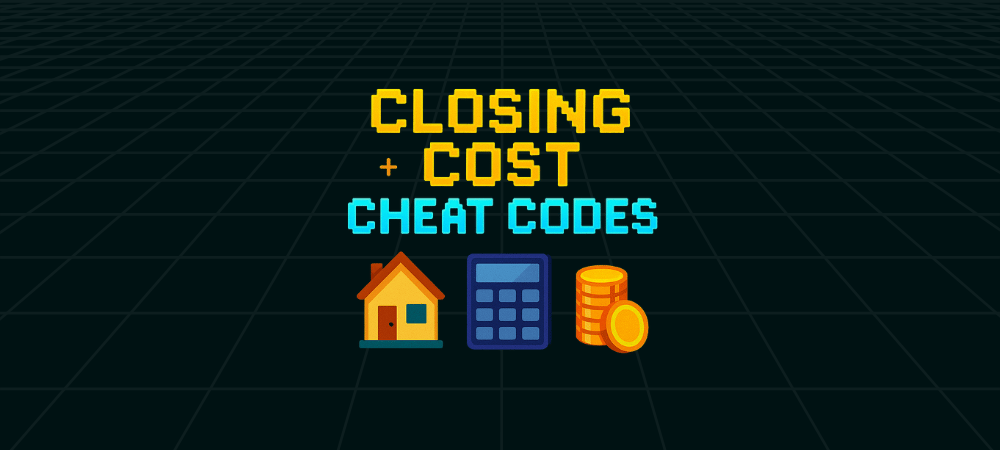
12-Month Game Plan to Buy a Home (Without Losing Your Mind)

Watch the YouTube video if you're a visual learner
Buying your first home can feel like stepping into the unknown, and stats back it up. Over 40% of Americans say it’s more stressful than planning a wedding or even losing a job. But what if you had a game plan to cut through the noise, get organized, and buy smart?
This post breaks down exactly that. A 3 Chapter Game Plan. Think of it like your pre-homeownership bootcamp. No fluff. Just the lending framework, money strategies, and real-world tactics that actually move the needle.
Let’s dive in.
Chapter 1: Understand the Lending Trifecta

You can’t win the home buying game without understanding the three pillars that determine your purchasing power:
-
Income (Money In)
-
Credit (Money Out)
-
Assets (Money Saved)
Most buyers focus too much on credit scores when the real bottleneck might be lack of savings. Identifying your true constraint helps you focus your energy where it matters.
Takeaway: Know your bottleneck. Then build from there.
Income – How Lenders Really View Your Money
When lenders evaluate your income, they’re not just looking at what you earn—they’re focused on how predictable and consistent your income is.
For Hourly or Salary Income
If you’re full-time and receive a steady paycheck, the formula is straightforward:
Hourly Rate × 2,000 ÷ 12 = Monthly Income
📌 Pro Tip: While 2,080 is the real number of work hours in a year, lenders often use 2,000 to keep things simple.
So, if you make $50/hour:
-
$50 × 2,000 = $100,000 annual
-
$100,000 ÷ 12 = $8,333/month
This is your gross income before taxes, and it forms the foundation of your loan pre-approval.
For Varying Income (Overtime, Bonuses, Commissions)
If your income isn’t consistent month-to-month (think nurses, cops, sales reps, or folks earning OT) lenders need a longer view. You’ll average the past 24 months of income to stabilize those fluctuations.
Here’s how it looks visually:

Let’s say you earned:
-
$20,000 in 2024
-
$10,000 in 2023
-
Total = $30,000 in overtime and bonuses
To get your average monthly income:
-
$30,000 ÷ 24 months = $1,259/month
That’s what lenders will use for qualifying, even if you’re now earning more today.
Always aim to include the last paystub from each year, since they show year-to-date earnings (including bonuses, OT, differentials, etc.). This ensures you're using the most complete picture.
Action Step: Grab your 2023 and 2024 final paystubs, total your varying income, and divide by 24 months. That number goes straight into your lending profile.
Bottom Line: Lenders love consistency. But it's ok if your income is steady or spiky. If you have less than 24 months of history, there are programs that allow less. Reach out to an expert and they can guide you through the exceptions.
Credit – It's Not Just About the Score
Lenders pull from 3 credit bureaus (Equifax, TransUnion, Experian) but only use the middle score. If you're buying with a partner, they use the lower middle score between you both.
Example: Just You
| Credit Bureau | Score |
|---|---|
| Equifax (EQ) | 650 |
| TransUnion (TU) | 700 |
| Experian (EXP) | 720 |
Lender Uses: 700 (The middle of the three)
Example: If You’re Buying With a Partner
| EQ | TU | EXP | Middle Score | |
|---|---|---|---|---|
| You | 650 | 700 | 720 | ✅ 700 |
| Partner | 680 | 690 | 710 | ✅ 690 |
Lender Uses: 690 (Lower of the two middle scores)
Next, focus on monthly payments, not total debt. A $2 monthly student loan payment on a $100K balance still only counts as $2. Crazy I know.
Student Loan Watch: If your payment is deferred, lenders use 0.5–1% of the balance, depending on the loan type (FHA, VA, conventional).
| Loan Type | Calculation Method | Example ($1,000 Balance) |
|---|---|---|
| Conv. | Use either 1% or 0.5% of total balance | $1,000 × 0.01 = $10/mo $1,000 × 0.005 = $5/mo |
| FHA | Use 0.5% of total balance | $1,000 × 0.005 = $5/mo |
| VA | Use 0.5% ÷ 12 (monthly equivalent of 6% annually) | $1,000 × 0.05 ÷ 12 = $4.16/mo |
Pro Tips:
-
If your student loan is not deferred, the actual monthly payment listed on your credit report is typically used.
-
VA loans tend to be the most forgiving, especially for larger balances.
-
Lenders will choose the higher of the two methods (1% or 0.5%) for conventional unless the loan program specifically allows for the lower rate.
Assets – Count What You’ve Saved (and How Fast You’re Saving)

Split your accounts into:
-
Non-retirement: Checking, savings, brokerage, etc.
-
Retirement: 401(k), IRA, etc.
Now Calculate Your Savings Velocity
This shows how much you're actually saving—not just what you have. Lenders love this metric because it paints a clearer picture of your financial habits.
Step 1: Total Deposits & Withdrawals (Last 3 Months)

In this example:
-
Deposits over 3 months = $20,000
-
Withdrawals = $10,000
Step 2: Subtract to Get Net Quarterly Savings

$20,000 - $10,000 = $10,000
That’s your net savings for the quarter
Step 3: Divide by 3 to Get Monthly Savings Rate

$10,000 ÷ 3 = $3,333/mo
This is your net velocity of savings.
In simple words: How much you’re truly setting aside each month after all your spending.
Action Step: Run your own 3-month savings audit. The numbers might surprise you (in a good way).
Want to forecast where you’ll be a year from now? Multiply your net savings per month by 12 and track the trend.
Know Your Numbers (Rules of Thumb)
Lenders care about your debt-to-income (DTI) ratio. Think of it like your financial gas tank.
If you earn $10K/month:
-
50% DTI = $5,000 toward all debts (including mortgage)
-
33% DTI = $3,300 (more sustainable)
-
20% DTI = the “forever home” safe zone
In high-cost markets like SoCal, buyers stretch closer to 50% DTI to get in. In slower markets, 33% is more common.
What’s the Minimum Down Payment?
Here’s a cheat sheet for minimum down payments:
| Loan Type | Min. Down | Notes |
|---|---|---|
| VA | 0% | For eligible veterans, active-duty service members, and certain spouses |
| USDA | 0% | Available for rural property purchases; income limits apply |
| Conv. (First-Time Buyer) | 3% | Lower entry point for first-time buyers |
| FHA | 3.5% | More flexible credit requirements |
| Conv. (Non-First-Time Buyer) | 5% | Standard minimum if you’ve owned property recently |
Don’t forget: You’ll also need to budget for closing costs, but a savvy real estate agent can often negotiate those into your offer or get them partially covered.
Chapter 2: Homeownership Free Trial
This is pure gold. Before you buy, run a “test drive” of your future mortgage.
Step 1 - Label a New Bank Account “Homeownership Savings”
This is your test zone. You’ll simulate your future mortgage here.
Step 2 - Calculate Your Hypothetical Mortgage
For example:
-
Projected mortgage = $3,300/mo
-
Current rent = $2,500/mo
-
Difference = $800 → This is your Savings Test.
Step 3 - Set Up a Split Direct Deposit

Ask your payroll provider (like ADP, Gusto, etc.) to route:
-
$800 into your new Homeownership Savings account
-
The rest into your regular checking for bills, groceries, etc.
Step 4 - Watch How It Feels
✅ If YES: you can comfortably pay all your bills!
❌ If NO: you feel a pinch or overdraft… no stress. You can transfer money back and tweak your test amount.
Step 5 - Adjust Based on Real Life
Maybe $3,300 was a stretch. Let’s say you were short $200 at the end of the month. Drop your test payment to $3,100/mo, and retest the next cycle.
Step 6 - Recalculate Your New Savings Test

If your updated comfortable mortgage is now $3,100/mo, and your current rent is $2,500/mo, then your new savings test is $600/mo.
Takeaway: You’re simulating homeownership risk-free.
Chapter 3: Monitor the Market Like a Pro

Using the Purchase Price information you received from your Mortgage Advisor.
Then you can use Zillow, Redfin, and your real estate agent together to Monitor the Market:
-
Set realistic price filters based on your budget
-
Save searches and get daily alerts
-
Watch trends in your target neighborhoods for 6–12 months
Avoid This Trap: Don’t trust Zillow’s monthly payment estimates, they often underestimate property taxes. Use purchase price for cleaner comparisons.
Takeaway: You're learning what your budget really buys in your market.
Revisit the Game Plan
If you’re not seeing homes you love at your comfort price, it’s time to tweak:
-
Adjust your income assumptions
-
Pay down more debt
-
Increase your savings velocity
Lurn Gold Nugget: It’s not about perfection. It’s about progress.
Main Takeaway: You're Not Behind. You're Building
Buying a home isn’t a single decision, it’s a dozen small ones stacked up. This plan helps you remove guesswork and replace it with clarity.
Recap: Track your income. Test your budget. Watch the market. And revisit.
Perfect timing is a myth. But perfect preparation is not.
Stay ready, buy smart,
Nathan





